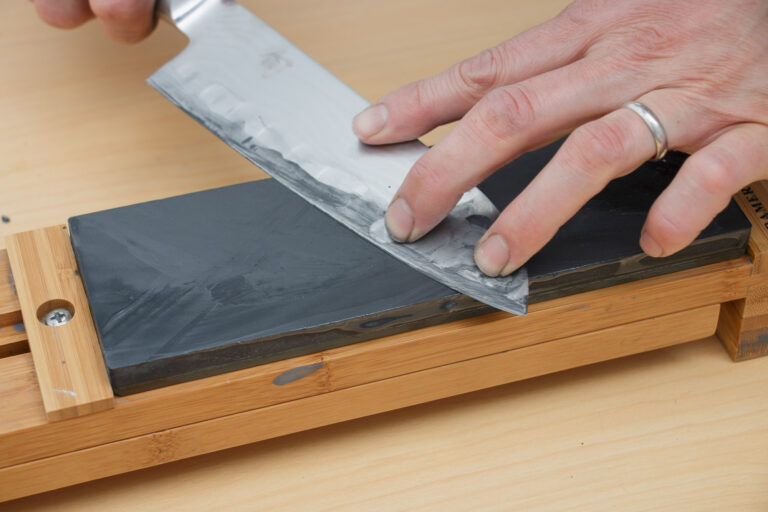A sharp knife is one of the most essential tools in any kitchen. Dull knives not only make cooking frustrating but can also be dangerous, as they require more force and increase the risk of slipping. That’s why learning how to sharpen a knife with a whetstone is a skill every home cook, chef, and even outdoor enthusiast should master. In this guide, we’ll walk you through step-by-step instructions, cover different types of knives, and share helpful tips to make sharpening safe and effective.
If you don’t have the time or want professional results, you can also explore our expert knife sharpening service, which restores your blades to like-new sharpness.
What is a Whetstone?
Before we get into how to sharpen a knife with a whetstone, let’s understand what a whetstone actually is. A whetstone, sometimes called a sharpening stone, is a rectangular block made of natural or synthetic materials used to sharpen and hone knife blades. Whetstones come in different grit levels, which indicate how coarse or fine the stone is.
- Coarse grit (200–600): Best for repairing very dull or damaged knives.
- Medium grit (800–2000): Great for regular sharpening.
- Fine grit (3000+): Perfect for polishing and finishing the blade edge.
How to Sharpen a Knife with a Whetstone (Step-by-Step)
Now let’s dive into the actual process. Knowing how to sharpen a knife with a whetstone takes some practice, but once you get the hang of it, it becomes easy.
Step 1: Soak the Whetstone
Most whetstones need to be soaked in water for 10–15 minutes before use. This helps reduce friction and prevents damage to both the knife and the stone.
Step 2: Place the Whetstone Securely
Set the whetstone on a stable surface, ideally on a non-slip mat or towel. A moving stone can be dangerous.
Step 3: Position the Knife at the Right Angle
Hold your knife at about a 15–20 degree angle to the whetstone. This angle works well for most kitchen knives, but Japanese knives often need a sharper angle (10–15 degrees).
Step 4: Sharpen One Side of the Blade
Starting at the heel of the knife, move the blade across the stone in a sweeping motion toward the tip. Apply gentle, even pressure and repeat this motion 8–10 times.
Step 5: Sharpen the Other Side
Flip the knife and repeat the same process for the other side of the blade. Keep the angle consistent for best results.
Step 6: Progress to a Finer Grit
If your whetstone has two sides (coarse and fine), repeat the same process on the fine side for a polished edge.
Step 7: Rinse and Test the Knife
Rinse the knife and whetstone with clean water. Test the sharpness by slicing through paper or gently cutting a tomato. A sharp knife should glide effortlessly.
How to Sharpen a Knife with Whetstone: Common Mistakes to Avoid
Many beginners make errors while learning how to sharpen a knife with whetstone. Here are some mistakes to watch out for:
- Using the wrong angle (too steep or too shallow).
- Applying too much pressure instead of letting the stone do the work.
- Not soaking the whetstone long enough.
- Forgetting to sharpen both sides evenly.
- Skipping finer grits and ending up with a rough edge.
How to Sharpen a Bread Knife with a Whetstone
Serrated knives like bread knives are trickier to sharpen, but it’s possible. Learning how to sharpen a bread knife with a whetstone involves focusing on each serration. Use the pointed corner of the whetstone to gently sharpen inside the grooves, one at a time. After finishing all serrations, lightly hone the flat side of the blade to remove burrs.
Most people find bread knives challenging, so professional help through a knife sharpening service is often the best choice. Still, practicing how to sharpen a bread knife with a whetstone can extend its life between professional sharpenings.
How to Sharpen a Japanese Knife with a Whetstone
Japanese knives are famous for their thin, razor-sharp blades. That’s why knowing how to sharpen a Japanese knife with a whetstone correctly is important. These knives usually require a sharper angle (around 10–15 degrees) to maintain their precision.
To practice how to sharpen a Japanese knife with a whetstone, start with a medium grit stone to preserve the delicate edge, then finish with a fine grit stone for a mirror-like polish. Patience and light pressure are key.
How to Sharpen a Kitchen Knife with a Whetstone
For everyday cooking, mastering how to sharpen a kitchen knife with a whetstone is essential. Kitchen knives are used daily, and frequent sharpening keeps them safe and efficient.
To practice how to sharpen a kitchen knife with a whetstone, follow the same step-by-step process outlined earlier. Regular maintenance every few weeks will prevent dullness and ensure your kitchen prep stays smooth.
Benefits of Sharpening Knives with a Whetstone
- Better Control: You decide the angle and sharpness.
- Longer Knife Life: Prevents unnecessary grinding.
- Cost-Effective: One whetstone lasts for years.
- Safer Cooking: Sharp knives reduce accidents.
- Professional Results: With practice, you can achieve razor-sharp edges.
FAQs About Sharpening Knives with a Whetstone
1. How long does it take to sharpen a knife with a whetstone?
It usually takes 10–15 minutes, depending on the knife’s dullness and your experience level.
2. Do I need to use oil on a whetstone?
Most whetstones require water, not oil. Always check the manufacturer’s instructions.
3. Can I damage my knife by sharpening it incorrectly?
Yes. Using the wrong angle or too much pressure can wear out the blade faster. Practice with care.
4. How often should I sharpen my kitchen knives?
For home cooks, every 2–4 weeks is enough. Professional chefs may sharpen their knives more often.
5. Should beginners try sharpening Japanese knives?
Yes, but with caution. Japanese knives are delicate, so mastering the basics on regular kitchen knives first is a good idea.
Conclusion
Learning how to sharpen a knife with a whetstone is a valuable skill that saves money, improves safety, and keeps your knives working like new. Whether you’re maintaining a bread knife, a Japanese knife, or your everyday kitchen knife, whetstones offer the best results with practice and patience.
For those who prefer professional help, our knife sharpening service ensures precision and convenience, giving your blades the care they deserve.

